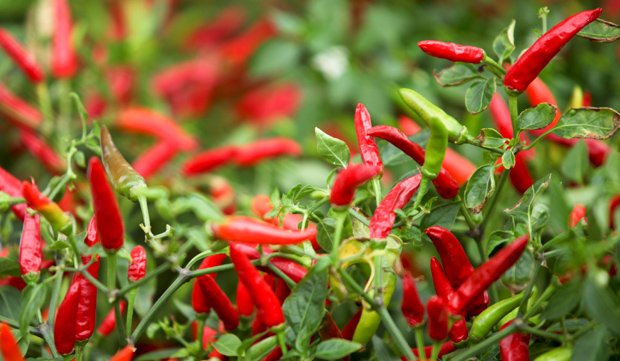Why some chillies are hotter than others

CHILLIES WITHOUT HEAT don’t have the benefit of burning their enemies, but somehow they persist in the wild.
A new study has shown that non-pungent (mild) chillies have a different advantage: they can thrive when water is scarce.
Chillies evolved their spiciness to deter a fungus that feasts on chilli flesh and seeds. But it turns out that investing heavily in defence is not always the best option. In dry environments, where plants have to be water efficient, it’s the chillies without heat that flourish.
“Under water-stressed conditions, non-pungent chilli plants produced twice the number of seeds as pungent plants,” says lead author Dr David Haak, who conducted the research at the University of Washington and in the forests of south-eastern Bolivia.
“So chilli peppers have to make a trade-off between water use efficiency and making compounds for defence,” David told Australian Geographic.
The study was published today in the Proceedings of the Royal Society B.
Fighting off chilli fungus
Traditionally, scientists believed chillies evolved chemicals called capsaicinoids to fend off hungry mammals. But research by David and his colleagues has shown that this isn’t the full story. In fact, it appears chillies evolved heat mainly to defend against the destructive Fusarium fungus.
“While there may still be a role for herbivorous mammals, protection against the fungal pathogen appears to be much more important,” David says. “Over seven years in our study sites we have yet to find a small chilli-eating mammal.”
Working in Bolivia, the research team were puzzled by the fact that – even though the fungus is present almost everywhere – up to 90 per cent of chilli plants in some areas had no spice at all.
“So my goal was to find out: Why don’t we see pungent plants predominating in all of the populations? You’d expect even a mild increase in pungency would convey huge fitness benefits,” David says.
The team studied the chilli species Capsicum chacoense across a 300km section of its natural range in Bolivia. Towards the southwest of the area, the proportion of strong chillies increased dramatically – as did the average level of rainfall.
Although the Fusarium fungus has infiltrated most populations, it’s more malicious in the wetter areas. Here, it pays to be pungent; every single chilli surveyed in the southwest corner was hot.
But in dryer areas, non-spicy plants are more common as fungal defences aren’t as important here. The team surmises that it makes more sense to use that energy to be water-efficient and produce lots of seeds.
Non-pungent chillies seem to use water efficiently by possessing fewer pores (stomata) on their leaves to minimise water vapour loss.
The next superhot chilli
Mark Peacock, a chilli expert from the University of Sydney, says the study provides strong evidence for why some chillies are hot and others are not.
Earlier this year, Mark helped cultivate the world’s hottest chilli, the Trinidad Scorpion Butch T. He says David’s research may also help chilli growers in their search for the next “superhot variety”.
“The findings certainly do indicate that we should be screening wild type varieties from wet climates, with high mammalian and fungal pathogen pressure,” Mark says.
“I think this work sheds light on the likely genetic heritage of our Trinidad Scorpion more than anything,” he says. “I think it’s safe to say that it came from a wet climate!”
RELATED STORIES

